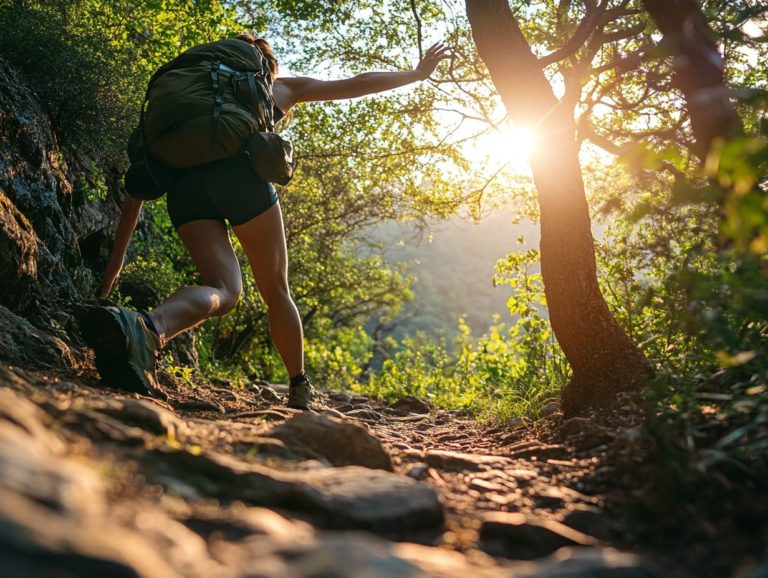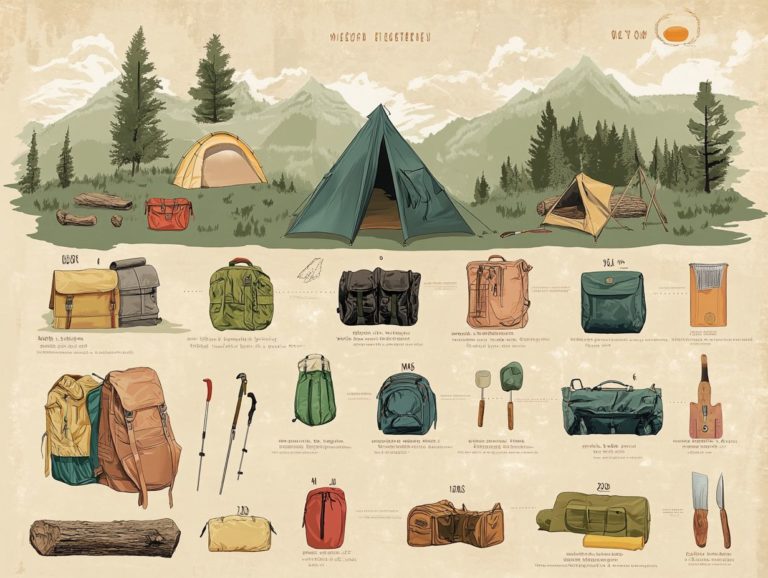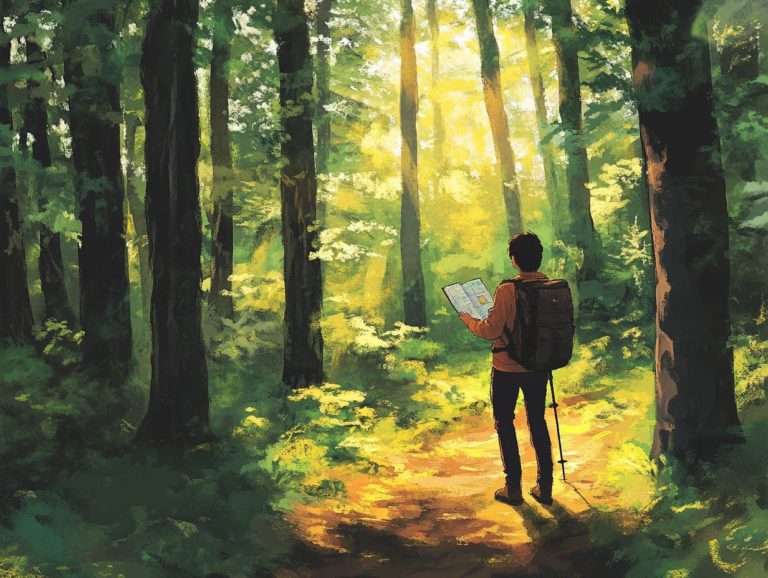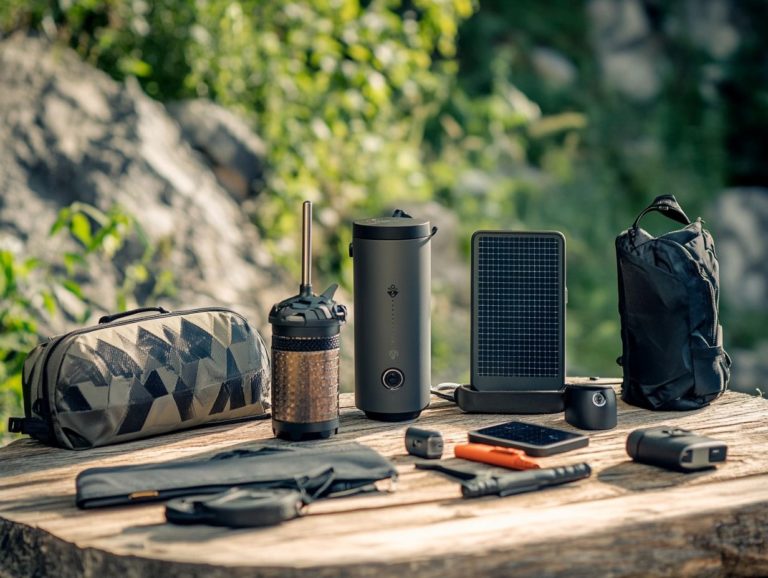The Ultimate Checklist for Hiking Gear
Planning a hike can be an exhilarating experience, but having the right gear is crucial for ensuring both safety and enjoyment.
Whether you’re setting out for a day trip or gearing up for an overnight adventure, preparation is essential.
This article provides a thorough checklist of essential gear, covering everything from clothing and footwear to navigation tools and emergency supplies.
You’ll also find tips for minimizing weight, preparing for varying weather conditions, and avoiding common packing mistakes.
Get ready to hit the trails with confidence and enjoy every moment!
Contents
- Key Takeaways:
- 1. Backpack and Gear Essentials
- 2. Navigation Tools
- 3. Clothing and Footwear
- 4. Shelter and Sleeping Gear
- 5. First Aid Kit
- 6. Food and Water
- 7. Hygiene and Personal Care Items
- 8. Emergency and Survival Equipment
- 9. Lighting and Communication Devices
- 10. Tools and Accessories
- 11. Sun Protection
- 12. Insect Repellent
- 13. Hiking Specific Items
- 14. Optional Items
- 15. Maintenance and Repair Items
- What Are the Must-Have Items for a Day Hike?
- Frequently Asked Questions
- What is included in the Ultimate Checklist for Hiking Gear?
- Why is it important to have a checklist for hiking gear?
- Is the Ultimate Checklist for Hiking Gear the same for all types of hikes?
- What are some key items that should always be on the checklist?
- Can I customize the Ultimate Checklist for Hiking Gear to fit my personal needs?
- Where can I find a printable version of the Ultimate Checklist for Hiking Gear?
Key Takeaways:
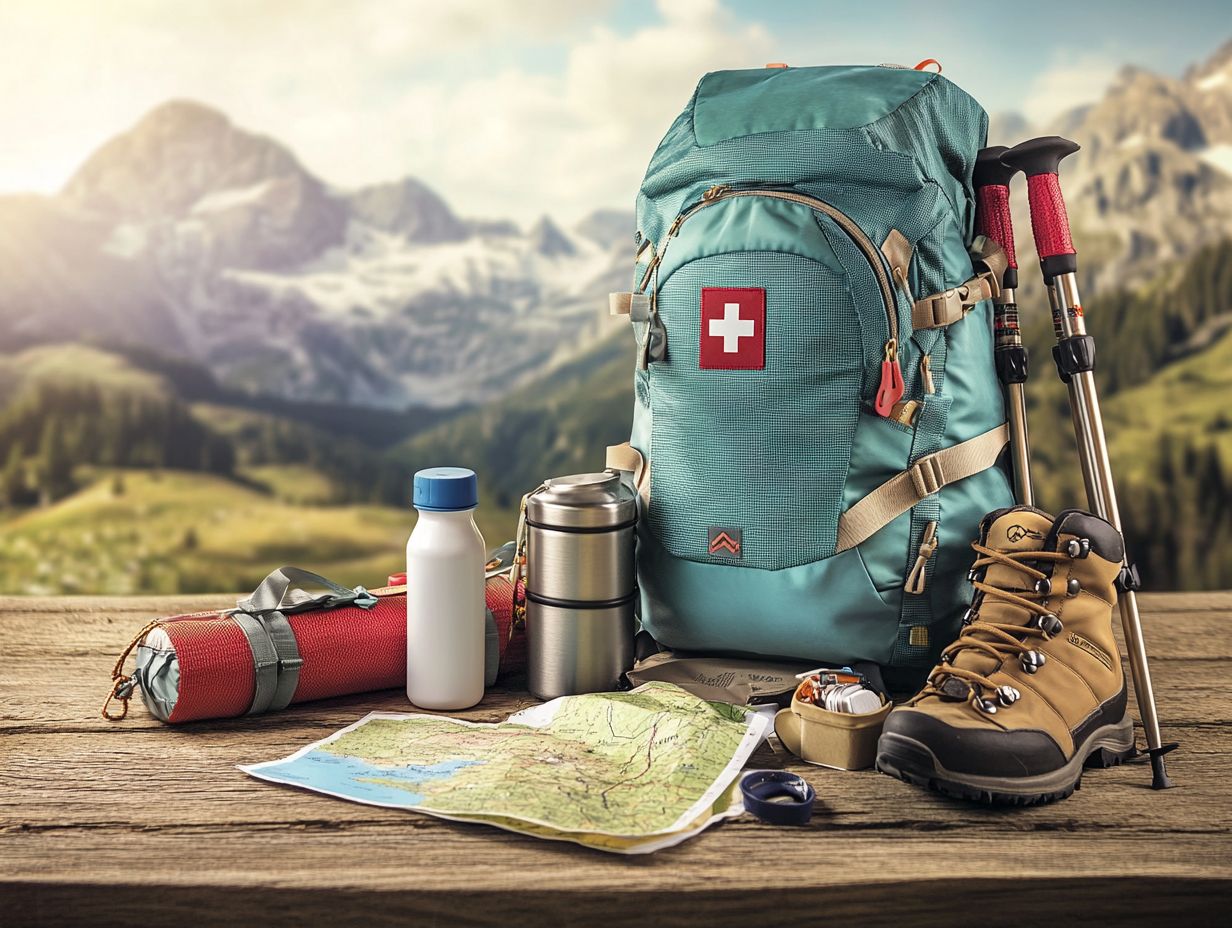
- Ensure the essentials: A backpack, navigation tools, clothing, and shelter are must-haves for any hike, whether it’s a day or overnight trip.
- Safety first: A well-stocked first aid kit, emergency equipment, and reliable communication devices should be included in any hiking gear checklist.
- Be prepared for all scenarios: Pack for different weather conditions, including sun protection, insect repellent, and extra layers. Always double-check your gear and avoid overpacking.
1. Backpack and Gear Essentials
When planning for a day hike, your choice of backpack and gear essentials becomes the cornerstone of a successful and enjoyable outdoor experience. These decisions significantly influence your comfort, safety, and overall enjoyment on the trail.
Crafting a well-organized hiking checklist is vital; it serves as your guide to remember all the necessary gear tailored for various trail and weather conditions.
Opting for a lightweight backpack that comfortably holds your hiking essentials allows you to carry everything from navigation tools to food and snacks without feeling burdened.
To enhance efficiency, compartmentalizing items within your pack is a smart move. Securing vital gear, such as trekking poles, provides stability and helps reduce strain on your legs during challenging climbs.
Water storage is equally important. Consider packing a hydration bladder or a water bottle that fits snugly in the designated sleeve for easy access while you re on the move.
Organizing snacks in separate, easily reachable pockets keeps your energy levels up without the hassle of digging through your entire backpack. By taking these elements into account, you position yourself for a truly successful adventure in the great outdoors.
Proper navigation tools are essential for any hiking adventure. They allow you to confidently traverse trails while keeping a keen eye on your surroundings and your destination even in unfamiliar territories.
With the right resources at your disposal, you can effectively manage your routes and adapt to unexpected circumstances. GPS devices, which are handheld devices that show your exact location, shine in this regard, providing real-time location data that is invaluable in dense forests where trail markers can be few and far between.
Meanwhile, traditional maps and compasses serve as trustworthy backups. They give you a broader perspective of the terrain and guide you through challenging weather conditions.
In bear country, knowing how to use these tools is crucial for maintaining awareness of both your position and any wildlife in the vicinity. Whether navigating rocky paths or pushing through thick underbrush, these tools are critical for ensuring a safer and more enjoyable hiking experience.
3. Clothing and Footwear
Choosing the right clothing and footwear is essential for ensuring a comfortable hiking experience. They shield you from the elements and provide necessary support, keeping you dry and warm throughout your journey on the trail.
Opting for breathable fabrics is crucial; they wick moisture away from your body, preventing overheating and discomfort during demanding hikes. Insulation layers are equally important, as they help regulate your body temperature in changing weather conditions, allowing you to focus on the breathtaking views rather than any discomfort.
Well-fitted hiking boots are your best friends on the trail. They offer crucial support and stability, reducing the risk of blisters and injuries on uneven terrain.
Making these thoughtful choices enhances your safety and elevates your enjoyment, fostering a more memorable connection with nature.
4. Shelter and Sleeping Gear
Before heading out on a day hike or overnight trip, make sure you have the right shelter and sleeping gear. This is essential for your safety and comfort, especially against unpredictable weather or unforeseen circumstances.
Selecting an appropriate backup shelter whether a lightweight tent, tarp, or bivy sack can dramatically enhance your experience. It can turn a potentially restless night into one of cozy reprieve. For backpackers caught off guard by sudden rain or a temperature drop, a well-insulated sleeping bag not only wraps you in warmth but also offers a comforting embrace, replenishing your energy for the next day s adventures.
A lightweight tent serves as more than a mere shield against the elements; it cultivates a sense of security and privacy that enhances your overall experience. When rainstorms arrive unannounced or nighttime temperatures plummet, having these vital essentials transforms what could be an uncomfortable outing into a refuge, allowing you to fully immerse yourself in the beauty of the outdoors without apprehension.
5. First Aid Kit
Don’t hit the trails without a well-stocked first aid kit! It’s your lifeline during outdoor adventures, ensuring you’re prepared for any potential injuries or emergencies.
Whether you re dealing with a minor cut, a sprained ankle, or something more serious, having the right supplies at your fingertips can truly be a lifesaver. The essentials you should include are:
- Adhesive bandages
- Antiseptic wipes
- Gauze
- Medical tape
Each of these items plays a crucial role in wound treatment. One particularly invaluable addition is the emergency blanket, which helps retain body heat in chilly conditions or provides shelter from the elements.
Knowing how to effectively use these components not only enhances your safety but also boosts your confidence in the wilderness. Being adequately prepared allows you to tackle any challenges that come your way, ensuring that every hiking trip is memorable and safe.
6. Food and Water
Adequate food and water are essential for maintaining your energy levels and hydration while hiking. They directly influence your stamina and overall experience as you explore the great outdoors.
Opting for high-energy snacks like trail mix, energy bars, and dried fruits significantly boosts your endurance. Protein-rich options like jerky or nut butter packs provide lasting fuel. Grab a hydration bladder for a hassle-free way to stay hydrated on the go!
Effective food storage solutions, like resealable bags or vacuum-sealed containers, keep your supplies fresh and protected from moisture and pests. This way, every bite maintains its flavor and nutritional value throughout your journey, allowing you to savor every moment in nature.
7. Hygiene and Personal Care Items
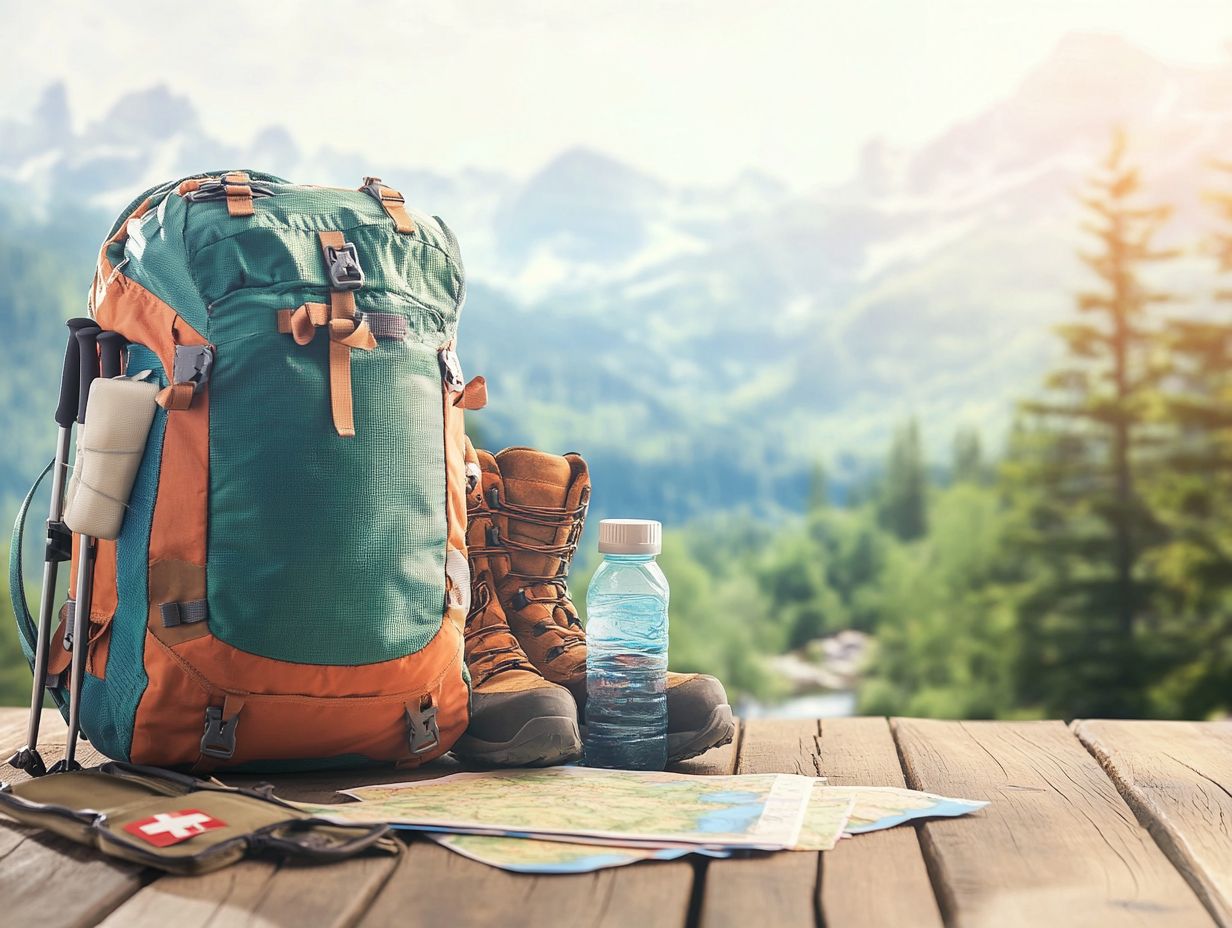
Maintaining hygiene while hiking is not just a matter of comfort; it s a crucial aspect of your health. Staying clean prevents infections and allows you to fully embrace the joys of the great outdoors.
Neglecting personal care can lead to discomfort, diminishing the thrill of your nature explorations. Pack essential hygiene products like biodegradable soap to stay clean and green! Not only does biodegradable soap minimize your environmental footprint by breaking down naturally, but it also keeps things clean without harmful residues.
As you prepare for your wilderness adventure, consider these tips:
- Carry refillable containers for your products to reduce waste.
- Use a microfiber towel for quick drying it’s lightweight and efficient.
- Always respect local water sources by keeping soaps at least 200 feet away.
Spending just a few extra minutes on personal upkeep can significantly enhance your overall well-being during your hike.
8. Emergency and Survival Equipment
Being equipped with emergency and survival gear can truly be a lifesaver during your day hike. This preparation makes a big difference for those unexpected situations that could jeopardize your safety and well-being.
Having a well-stocked pack means you ll have the right tools and supplies right at your fingertips when unforeseen circumstances pop up. Items like an emergency blanket are critical for retaining body heat in chilly conditions.
On the other hand, bear spray provides a layer of protection from wildlife encounters, ensuring a safer experience as you explore the great outdoors.
It s equally important to keep a list of emergency contacts and emergency shelter handy, so help is just a call away if the need arises. This combination of preparation and gear can truly make all the difference.
9. Lighting and Communication Devices
Proper lighting and communication devices are essential for hiking. They ensure your safety and help you navigate during emergencies or unexpected delays.
Headlamps are particularly appealing for their hands-free convenience and adjustable brightness levels. They re perfect for setting up camp after dark or navigating rocky terrain.
While flashlights may seem more traditional, they offer powerful beams that illuminate a wider area, allowing you to spot hazards well in advance. Lanterns are fantastic for group settings or cozy nights around the campfire, creating a warm atmosphere while enhancing visibility.
Having a reliable power bank and solar charger is crucial, especially for your GPS devices. These tools can be life-saving when exploring remote areas. Keeping your electronics charged ensures you remain oriented throughout your adventure.
10. Tools and Accessories
The right tools and accessories can elevate your hiking experience, transforming it into something not just comfortable but truly enjoyable especially during those much-needed breaks or overnight camping trips.
Picture this: you arrive at your campsite and effortlessly set up a cozy spot with comfortable chairs that invite you to unwind after a long trek. Portable stoves become your best friend, allowing you to whip up a warm meal in mere moments.
With useful cooking utensils like lightweight pots, lightweight cookware, and spatulas, you can turn a simple outdoor dinner into a delightful culinary adventure. Whether you re embarking on a quick day hike or an extended wilderness escapade, these essentials add not just convenience but also a touch of luxury to your outings.
By investing in quality gear, you can focus on what truly matters immersing yourself in the beauty of nature while leaving the logistics to the tools that enhance your journey.
11. Sun Protection
Sun protection is essential when you’re gearing up for any outdoor adventure, including hiking. It s your ultimate shield against sunburn and the long-term skin damage from those sun-soaked escapades in nature.
Applying a broad-spectrum sunscreen with an SPF of at least 30 is crucial, especially if you re in bear country. This ensures you re effectively blocking harmful UVA and UVB rays, allowing you to immerse yourself in the great outdoors with peace of mind.
In addition to sunscreen, consider donning protective outdoor clothing, such as long sleeves and hiking pants made from lightweight, breathable fabrics. This way, you ll enjoy that extra layer of coverage without sacrificing comfort.
Don t forget to accessorize with wide-brimmed hats and UV-blocking sunglasses. These not only enhance your style but also safeguard sensitive areas like your eyes and face from the relentless sun.
Together, these measures amplify your enjoyment during outdoor outings and play a crucial role in maintaining your skin s health for the long haul.
12. Insect Repellent
Insect repellent is a must-have on your hiking checklist. It protects you from those annoying bites that can ruin your outdoor experience and lead to health concerns.
You ll find various types of insect repellents available, including those with DEET a common chemical in bug spray that repels insects picaridin, or more natural options like citronella and eucalyptus oil. Each type has its own strengths for different activities, whether you re navigating through thick woods or having a leisurely picnic by the lake.
Proper application is key make sure to cover all exposed skin and clothing, but steer clear of your eyes and mouth. In areas notorious for high insect activity, relying on a dependable repellent boosts your comfort and lowers the risk of diseases like Lyme disease or West Nile virus. This way, every outdoor adventure becomes safer and more enjoyable.
13. Hiking Specific Items
Certain hiking-specific items can significantly enhance your comfort and efficiency on the trails, allowing you to immerse yourself fully in the beauty of the outdoors.
Among these essentials are walking sticks, which provide stability on uneven terrain. They help reduce strain on your joints by distributing your weight properly, making steep ascents and descents much more manageable.
Hydration bladders and water storage ensure that you stay hydrated throughout your journey. These devices allow for easy sipping without stopping to fumble with water bottles. This lets you focus on the breathtaking scenery around you.
Equipped with these hiking essentials, you can tackle challenging routes and long distances more effectively while savoring every moment of your experience.
14. Optional Items
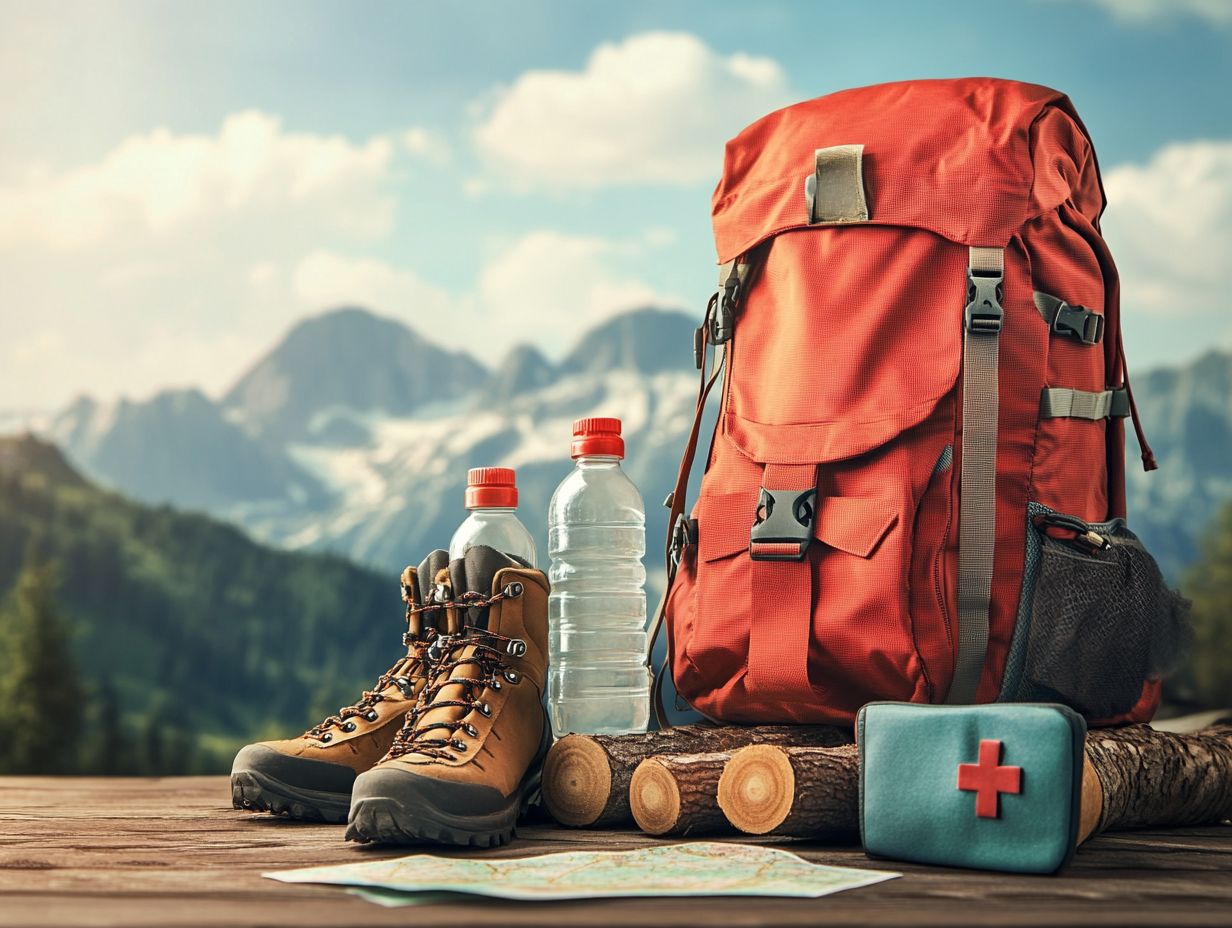
Optional items can elevate your hiking experience, allowing you to customize your adventure according to your preferences and needs.
For example, incorporating camping games into your itinerary can spark camaraderie and laughter among friends or family, making the trek truly unforgettable. Picture this: hearty laughs shared around the campfire make every moment memorable.
Similarly, a star chart can transform a night spent beneath the open sky into an enlightening escapade, captivating you with the wonders of the cosmos. These simple additions amplify the sense of discovery and forge lasting memories, ensuring that every outing is one-of-a-kind.
Such thoughtful enhancements turn an ordinary hiking trip into an extraordinary journey, encouraging you to connect more deeply with nature and with each other.
15. Maintenance and Repair Items
Having maintenance and repair items at your disposal can truly transform your hiking experience. They shield you from unexpected mishaps and allow for swift fixes that keep you comfortably and safely on the trail.
A reliable multi-tool is also essential, packed with versatile functionalities. Specific items like duct tape and repair patches ensure that minor issues don t escalate into significant problems.
Carrying extra shoelaces can prove to be a game changer for surprise breaks. Meanwhile, a compact first aid kit stocked with band-aids and antiseptic and hygiene products becomes a critical ally for any outdoor adventure.
Together, these tools enhance the longevity of your hiking gear, enabling you to relish the journey without the nagging worry of equipment failures.
What Are the Must-Have Items for a Day Hike?
When you’re gearing up for a day hike, several must-have items will ensure a safe and enjoyable outdoor experience. Creating a comprehensive hiking checklist is key to covering all your essential gear needs, like a first aid kit.
Prioritize navigation tools like a map and compass or a GPS device to help you stay on track. Proper clothing is equally important; layering your outfits with insulation layers will allow you to manage temperature changes throughout the day effectively.
Your food options should include high-energy snacks and plenty of water to keep your hydration levels up. Don t forget to pack a first aid kit and navigation equipment it can be a lifesaver in minor injuries or emergencies.
By considering these essentials, you’ll set out with confidence and peace of mind, ready to embrace the adventure ahead.
In summary, being prepared for hikes is crucial. Using this checklist effectively will maximize your hiking experience and ensure you enjoy every moment spent in nature.
What Are the Essential Items for an Overnight Hike?
An overnight hike demands a bit more planning and specialized gear compared to a day hike, especially when it comes to ensuring you re equipped for a night under the stars and protected from the elements in the wilderness.
While it might seem a bit overwhelming at first, having the right essentials can transform this adventure into a comfortable and safe experience. A quality sleeping bag for warmth and emergency blanket are essential for warmth and shelter, especially when temperatures drop after sunset.
Plus those, don t forget about cooking tools like a lightweight stove, pots, and utensils, which allow you to whip up meals. This not only provides nourishment but also adds a welcome sense of routine to your trip.
Watch the weather closely. Packing layers, rain gear, and other weather-appropriate items like hiking boots will help you stay dry and cozy, ensuring your adventure remains enjoyable, no matter how unpredictable Mother Nature decides to be.
How Can One Minimize the Weight of Their Hiking Gear?
Minimizing the weight of your hiking gear can significantly enhance your experience, granting you greater mobility and stamina on the trails, especially during long outdoor excursions.
By thoughtfully selecting a lightweight backpack and opting for compact cookware, you can surprisingly lighten your load without sacrificing functionality. It s essential to evaluate your gear carefully; for example, choosing freeze-dried meals (pre-packaged meals that only need hot water to prepare) can save both weight and space, while swapping bulky cooking pots for foldable or tools that serve multiple purposes can further trim excess baggage.
Consider leaving behind non-essential clothing, extra pairs of shoes, and any food supplies that may not be crucial for your journey. Striking a balance between safety and minimalism is vital, allowing you to explore with ease while keeping essential gear handy for emergencies.
What Are Some Common Mistakes to Avoid When Packing for a Hike?
Avoiding common mistakes when packing for a hike is crucial for ensuring a smooth and enjoyable experience. Improper preparation can lead to discomfort or even dangerous situations.
Understanding the nuances of what to bring can be the difference between a delightful adventure and a problematic one. Hikers often find themselves wrestling with issues like overpacking, which can weigh them down, or forgetting essential items such as first aid kits or adequate water supplies. To ensure you have everything you need, check out these winter hiking gear essentials.
To navigate these challenges, prioritize lightweight gear, create a checklist of must-have items, and even practice light packing techniques at home. Always check the weather before heading out; it can make all the difference!
Being prepared will make your day on the trail much better.
How Can One Prepare for Different Weather Conditions While Hiking?
Preparing for various weather conditions while hiking is essential for your comfort and safety, as unpredictable changes can unfold throughout your outdoor adventure.
Equipping yourself with the right clothing layers enables you to easily adapt to shifting temperatures, whether you encounter a sudden chill in the air or an unexpected downpour. The beauty of layering isn’t just about putting on or taking off a base layer; it’s also about including insulation layers that can trap warmth without adding unnecessary bulk.
By understanding the weather forecast, you can select gear that is not only suited for the day s conditions but also effective in handling sudden shifts. This ensures you remain dry and comfortable throughout your hike.
Frequently Asked Questions
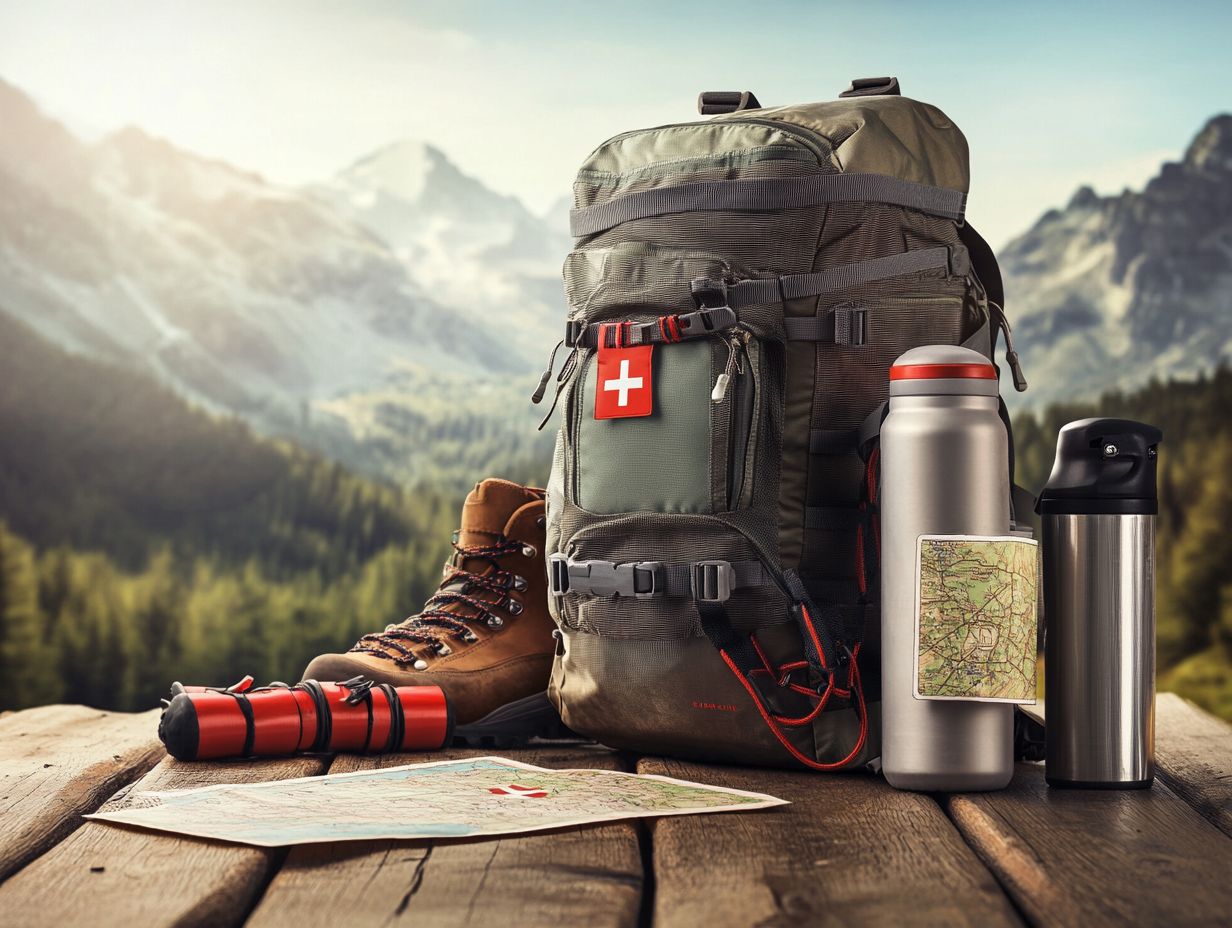
What is included in the Ultimate Checklist for Hiking Gear?
The Ultimate Checklist for Hiking Gear includes all the essential items needed for a safe and successful hiking trip, such as proper clothing, footwear, navigation tools, and emergency supplies.
Why is it important to have a checklist for hiking gear?
A checklist ensures that you have all the necessary items before heading out on a hike, reducing the risk of forgetting important gear and making your trip more enjoyable.
Is the Ultimate Checklist for Hiking Gear the same for all types of hikes?
No. Your checklist varies based on the hike’s length and difficulty. Adjust it to fit weather conditions and terrain.
What are some key items that should always be on the checklist?
Some essentials include a map and compass.
Don’t forget a first aid kit, the right clothes, good footwear, and enough water and food to keep you energized!
Can I customize the Ultimate Checklist for Hiking Gear to fit my personal needs?
Absolutely! While there are must-have items, feel free to add or remove things based on what you like and what you need for each hike.
Where can I find a printable version of the Ultimate Checklist for Hiking Gear?
You can easily find printable checklists online.
Make sure to carefully go through and mark off each item before your hike!


